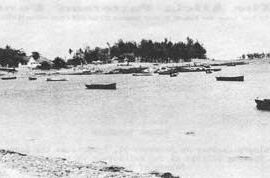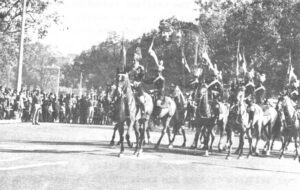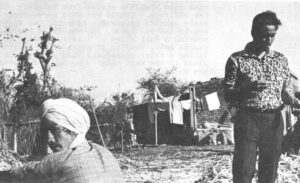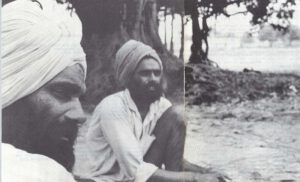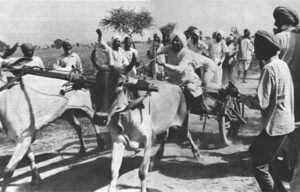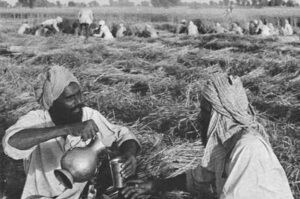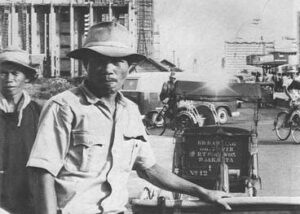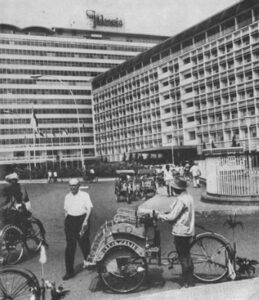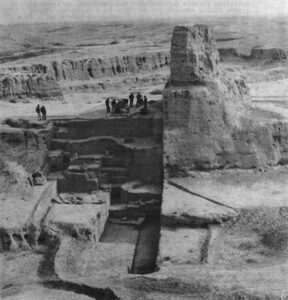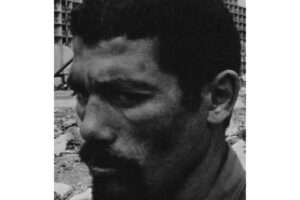June 12, 1970
Introductory note: The central, developing theme of previous articles in my study has been that if the governments of the poor nations cannot solve their problems of overpopulation and the social dislocation of the agricultural revolution, many of the world’s cities risk being inundated by a tidal wave of jobless men by the end of the 1970s, even if the poor two-thirds of the world manage to keep themselves fed. Calcutta may pass the 15 million mark, Buenos Aires 10 million, Cairo 6 million, with other cities in Afro-Asia and Latin America swelling even faster. In some cities, close to the majority of inhabitants may be uprooted peasants, a very large proportion of them without jobs. There must be reason to fear that in some cities riots and revolts will be fomented and that sometimes those of the rootless, jobless millions will join in. Chances are such revolutions will be called Communist, although it seems very unlikely they would be controlled by Peking, Moscow, Hanoi or Havana, all equally affected by the flood of peasants from the countryside. But it is likely local revolutionaries will look around for past models to follow. Today the names of Mao Tse-tung, Che Guevera and Franz Fanon are most often heard. Tomorrow it may be Le Duan, Ho Chi Minh’s successor, for the obvious reason that his highly pragmatic, Leninist strategy has been so effective in Vietnam. Since Le Duan’s revolutionary doctrine seems more exportable than Mao Tse-tung’s vision of attaining pure Marxism through permanent revolution, an analysis of it follows as an example of what can be expected should the race of industrial employment to keep pace with urban growth in the poor nations be partially lost).
“Southeast Asia is the center of the world revolutionary storm and is the convergence point of the most acute contradictions in the world…If the proletarian revolution is successful in this region, and if the densely populated countries – such as India and Pakistan with nearly 550 million people and Indonesia with more than 100 million people – also move toward socialism, then, as Lenin predicted, ‘There is no doubt about the conclusion of the struggle on a world scale.'”
When Le Duan, the First Secretary of the North Vietnamese Communist Party, wrote these words in a subsequently captured letter to General Nguyen Chi Thanh, the former Viet Cong commander, in March 1966, he was virtually unknown outside of Vietnam and the Communist world. Indeed, he did not clearly emerge as a global figure until he read Ho Chi Minh’s will at the Vietnamese Communist leader’s funeral last September. And even then, Le Duan did not clearly emerge as Ho’s successor and the new leader of North Vietnam until publication of a lengthy doctrinal statement last February. His party leadership apparently secure, he chiefly attracted attention this spring in his efforts to promote a united war effort by Russia and China during visits to Moscow and Peking.
Yet as early as 1965, many knowledgeable and informed South Vietnamese were already speaking of Le Duan as the man who was really running the war. Until then very little was known of him and nothing of his strategic doctrine.
Now 63, he was known to be the only member of the 11-man Politburo of peasant origin. Born in 1907 in a small village near Hue in South Vietnam’s northernmost province of Quang Tri, Le Duan had been recruited at age 22 by Ho himself into an anti-French “Revolutionary Youth Force.” A year later, he became a founding member of the Indochinese Communist party-formed, so the story goes, in the bleachers during a soccer game in Hong Kong. Le Duan spent five of the next six years serving his first sentence of hard labor on Con Son Island, but nevertheless rose rapidly in party ranks. Released in 1938 in a general amnesty of 7,000 Vietnamese political prisoners, granted by Leon Blum’s popular front government in Paris, Le Duan took over the party apparatus in the old kingdom of Annam, the coastal region around Hue that now straddles the demilitarized zone (DMZ).
For the next two years, 1938-39-while Ho was in China and Mao Tse-tung was writing his thesis on “people’s revolutionary war”-Le Duan lived in Hue. In September 1939, as the Nazis marched into Poland, the Communists in Vietnam were once more outlawed and arrested. Le Duan was again imprisoned on Con Son Island until Ho seized power in Hanoi in 1945.
During this second stay in prison, Le Duan worked in the penal colony’s medical dispensary as a menial orderly, despite his senior party rank. Although he presumably carried on party activities in prison, Le Duan was so adept as an actor and clandestine operator, that Tran Qaoc Buu, today South Vietnam’s leading trade unionist, worked as a clerk beside him daily for almost three years and never once thought of Le Duan as anything but an ordinary prisoner. “He seemed a very common peasant youth,” Buu told me last year. “You can imagine my amazement when he went to Hanoi and surfaced as a member of the Communist Central Committee. In all that time he never gave one sign that he was anything but an ordinary peasant.”
In 1951, Le Duan returned to what is now South Vietnam to arrange the liquidation of Nguyen Binh, a Tonkinese sailor trained in China who had become the charismatic leader of the Vietminh troops in the South. Binh was betrayed into the hands of the French, apparently as a scapegoat for an unsuccessful “general offensive” that Hanoi had ordered against the colonial forces in the Mekong Delta. Some authorities also believe it was Ho’s deliberate intention to have Le Duan purge the southern branch of the Vietnamese Communist party, rather than risk a victorious rival in Saigon.
Le Duan’s real rise to party power came in late 1956 with the disgrace and fall of Truong Chinh, a Chinese-trained propagandist two years Le Duan’s junior, who until then had been regarded as the leading Vietnamese Communist ideologue and Ho Chi Minh’s political heir apparent. The author of The August Revolution and The Resistance to Win, considered the foremost theoretical works produced by Vietnamese Communism, Chinh was, and is, slavishly pro-Chinese. His doctrinal ideas, like those of General Vo Nguyen Giap, the North Vietnamese military commander, are heavily borrowed from Mao Tse-tung’s own writings.
Chinh’s slavish Maoism led to his initial fall from grace. Put in charge of land reform two years after the defeat of the French and Ho’s seizure of Hanoi, Chinh carried out a forced collectivization of land with the help of Chinese cadres that was one of the most brutal and bloody peasant oppressions of modern times. Bernard Fall estimated more than 50,000 Tonkinese peasants died in the process and at least another 100,000 were imprisoned or deported. A climax was reached in November, 1956, when the peasants rebelled in the Red River Delta and the Communist regime itself was threatened. Ho hurriedly held a “correction of errors” campaign, forced Truong Chinh to resign as party leader and make a public “auto criticism.” If Chinh had not had the personal support of Mao Tse-tung, his career might have ended; instead, he remained a powerful behind-the-scenes figure in the Politburo. His chief importance over the years has been as a symbol of Chinese influence in North Vietnam and as Le Duan’s chief rival, both in the realms of actual power and in strategic doctrine. Although it is an over-simplification, Truong Chinh can probably be fairly described as the chief apologist for Mao Tse-tung and Maoism in the Hanoi leadership.
Although Ho Chi Minh made Le Duan de facto party leader in 1957 he was not given the official title until 1960. Until then, Le Duan had remained a very shadowy figure, even within the Vietnamese Communist leadership; it was generally believed he had been in charge of internal party organization and clandestine operations in both North and South going back almost twenty years. But it was not until 1960 that Le Duan began to emerge as the supreme ideologue and political strategist of the war for South Vietnam.
In 1959, Ho ordered the Viet Cong uprising in the Mekong Delta against Ngo Dinh Diem’s five-year-old government. As a native of the Hue region who had spent many years either in prison, in Hue or working underground in the Mekong Delta, Le Duan had some claim of being a South, rather than a North, Vietnamese. In September, 1960, he urged his “fellow Southerners” to join the newly formed Viet Cong guerrilla movement. The National Liberation Front (NLF) was founded the following December. From then on, Le Duan identified himself with the Viet Cong in the South, always taking credit for its military and political successes. During this period Truong Chinh’s main role was to publish doctrinal matter pushing the line the war should be waged according to strict Maoist principles, tactic and strategy. Chinh’s protégé in the North Vietnamese Army, General Thanh, was sent south eventually to command the Viet Cong, deliberately, some said, to get him out of Hanoi where he was a four-star rival to General Giap, even then, apparently, an ally of sorts of Le Duan. Chinh’s death by “heart attack” was announced in 1967 by Hanoi, but whether he was killed by a B-52 raid, liquidated or actually died of natural causes was never known.
Up until the fall of 1964, Le Duan seemed willing to adhere to the Chinese Communist revolutionary model of “people’s wars of national liberation,” given a Vietnamese coloration in the published works of Giap and Truong Chinh. A disciplined Communist party was visualized as running things from behind, while a broad united front-the NLF-conducted a protracted guerrilla struggle from a rural base of armed peasantry. At this time, China was North Vietnam’s principal foreign supporter, supplying half its budget and large amounts of arms.
Russia’s involvement in Vietnam began in 1961, with Khrushchev’s reaffirmation of Soviet support for “just wars of national liberation,” which were excepted from the doctrine of “peaceful coexistence.” In late October, 1963, just before the coup d’etat against Diem, Russia announced its specific support for Hanoi’s “war of national liberation” in South Vietnam. This was followed by commitments of money and diplomatic support from Communist bloc nations and, in December, 1963, a promise to give arms. This firm pledge of Russian backing appeared to be Le Duan’s main justification for departing radically from Maoist principles of protracted revolutionary warfare a year later, when Hanoi ordered the first of nine regular North Vietnamese Army divisions into the south.
The Chinese bitterly disapproved. Peking took the position-and still insists-that the Viet Cong should be waging a classical, long drawn-out guerrilla campaign to produce a victory that would vindicate Mao’s revolutionary methods throughout the poor nations. In addition, the larger the forces engaged, the more the Viet Cong and North Vietnam would have to depend on Russia for scientific modern methods, and the more Hanoi would have to shift to Moscow in the Sino-Soviet rivalry. Peking’s propagandists warned, “Acting contrary to Mao’s theory will lead only to defeat.” A similar line was taken by Truong Chinh in Hanoi, and in September, 1965, Peking went much further. Defense Minister Lin Piao, in what is now clearly seen as the first shot in the Great Proletarian Cultural Revolution, published his famous article “Long Live the Victory of People’s War.” Lin’s thesis postulated the nations of Asia, Africa and Latin America as the “countryside of the world” and the industrialized West as the “cities of the world.” The “cities,” according to Marshal Lin, would inevitably be isolated and eventually captured by the revolutionary forces of the “countryside.” The article had a special meaning on China’s role in the Vietnam war. While Marshal Lin stated unequivocally that a “people’s war” would receive encouragement and support from Peking, he also made it clear that each people must fight its own battles. Thus the principle of “self-reliance” could be invoked by the Chinese to withdraw their support from Vietnam if they ever chose to do so and the doctrinal basis was laid for attacks on too heavy dependence on Russia.
Even more significantly, Lin’s thesis followed the publication of major military articles by two rival senior generals in the Chinese army who soon became purge victims. Both had presented thinly veiled arguments, putting more faith in missiles than citizens’ armies and calling for a rapprochement with Russia before direct Chinese military intervention in Vietnam to match the growing American involvement. The purge of the two generals was eventually followed by the arrests and vilification of China’s President Liu Shiao-chi, Peking Mayor Peng Chen and General Party Secretary Teng Hsaio-ping, who along with their other posts, were in charge of China’s subversive effort abroad and had been Le Duan’s closest associates in Peking.
It was not until early 1966 that the dispute between the Le Duan group and the Maoists in Peking became open and acrimonious. In July, Le Duan politically challenged Mao’s favorite dictum, “Man, not weapons, decides the issue of war.” Man in the mass was important, Le Duan said, but so was modern technology. Besides, he went on to argue, the Vietnamese Communists have evolved “unique tactical methods,” based on applying teachings of Lenin to concrete Vietnamese situations, which enabled them to confidently predict success against the United States.
What these were, Le Duan did not spell out. But an unsigned article which appeared in the October 1966 issue of Hoc Tap, the North Vietnamese Communist party’s theoretical journal, appeared to be a further explanation and defense of Le Duan’s strategy against the Maoists. It was supposed Le Duan had written the article but this was not fully confirmed until last February’s major thesis in which he repeats the same arguments, almost word for word.
“On the basis of keeping firm in strategy,” the Hoc Tap article said, “our party cleverly applied its tactics; on the one hand it cleverly took advantage of the regional and temporary contradictions of the enemy to sow division among him. On the other, it united with anyone who could be united, won over anyone who could be won over, neutralized anyone who should be neutralized, completely isolated the imperialists and their most dangerous lackeys, and concentrated the spearheads of the attacks against them to overthrow them.”
In other words, his “most clever tactic,” Le Duan indicated, was the “careful, attentive” application of Lenin’s famous principle of exploiting internal contradictions in the enemy camp. The implication of the article was that the central thrust of North Vietnam’s strategy must not be military alone but rather directed toward destroying South Vietnam’s social structure, so that eventually there is nothing left to defend.
The Hoc Tap article gave prominence to a passage from Lenin:
“It is possible to defeat a stronger enemy only through displaying great effort and under the necessary condition of taking advantage very minutely, very attentively, very carefully and very cleverly of any rift, even the smallest one, among the enemy; any contradiction, even the smallest, among the interests of the bourgeoisie of various countries and among the interests of various bourgeois groups and factions in each country.”
The article described “culture and ideology” and “regional and temporary contradictions” as the most fruitful fields for applying Lenin’s principle. “Anyone who does not understand this truth,” it concluded, “understands neither Marxism nor scientific, modern Socialism in general.” At that time, the “anyone” was almost certainly Le Duan’s Maoist critics in Peking and Truong Chinh.
More light was shed on Le Duan’s doctrine in January, 1967, when a 26-page letter he had written to General Thanh was captured by American troops. In essence, Le Duan’s “unique tactical methods” seemed to be that by arriving at “correct solutions” through dialectical reasoning, one could completely manipulate and dominate masses of people, turning them into perfect tools for a cause.
In the letter, Le Duan explained how the human mind can be conditioned to successfully project a series of possible developments. A man could then plan a large number of alternative responses to anything his opponent might do-instead of responding to the unforeseen with a mixture of planned action and unplanned reaction, as is normally the case. One passage in particular provided exceptional insight into Le Duan’s skill as a master political chess player:
“We must have a correct thinking method: the materialist dialectical thinking method. To understand the social method, we must do our best to distinguish it from the mechanical reasoning methods. To speak of revolution and war is to speak of politics. Politics is a science and l’art du possible. (He used the French phrase). In a definite historical epoch, social facts may develop according to this possibility, or another, within the scope of the definite conditions of this epoch. In the face of a changing environment, we Marxist-Leninists cannot but base ourselves upon the development of this environment’s internal contradictions and upon the subjective and objective conditions it generates to anticipate its development possibilities and, on that basis, to set the lines and policies which are appropriate to our goals…Each social phenomenon always has many causes which interact, contradict and influence each other…While studying social sciences, if we reason in a simple and mechanical manner we can by no means find out the rules governing the dialectical development of things, and, of course, cannot manipulate this developmentso it is consistent with our purposes and requirements.” (italics mine)
While the Chinese kept warning against any deviation from Maoism, their criticism of Le Duan’s doctrine mainly centered on the demand that as a precondition for victory the Vietnamese should persevere in “protracted war,” that is, in Mao’s three-stage strategy of guerrilla warfare.
The main doctrinal counter-attack from Truong Chinh in Hanoi came in April, 1968, after the failure of the February Tet offensive to set off a popular uprising against the Americans and Saigon government in South Vietnam. In a lengthy thesis, which by the Fall of 1968 appeared to have been adopted by the Politburo as the official party line, Truong Chinh appealed for a return to classic Maoist “protracted war.”
Without citing Le Duan by name, Chinh attacked him for having “underestimated the enemy,” seeking “to throw all our forces into a few decisive battles” and arguing that “we should not protract the war.” Chinh repeatedly echoed Maoist principles, declaring revolutionary war most be protracted and self-reliant, not heavily dependent on foreign (i.e., Russian) help. In May, 1968, Chinh got adoption of the new rallying cry, “Long drawn-out fight and relying mainly on oneself,” code phrases for Maoism. Chinh likewise endorsed Mao’s support of perpetual revolution as a means of attaining pure Marxism, calling it “constant revolution” and advocated continued revolutionary violence in the North as well as in South Vietnam.
Attacking Le Duan’s defense of modern weapon technology, Chinh claimed that “in the people’s war, the spiritual weapon remains the most powerful.”
Whereas Le Duan in 1966 had attacked the slavishly pro-Chinese Chinh as “those of conservative spirit” who “mechanically copy the past experience of foreign countries,” Chinh now retorted, “We should selectively study and practice the experiences of the brotherly parties. We should not copy those experiences identically.” Chinh also took the opportunity of publishing a lengthy defense of his land reform policies twelve years before. His comeback to top ideological position, however, did not last long. Le Duan began returning to predominance soon after President Johnson on October 31, 1968, agreed to a complete bombing halt and to Viet Cong representation at the Paris peace talks. By the Spring of 1969, Chinh was absent from North Vietnam, reportedly seeking “medical treatment” in East Germany, an odd place for Peking’s chief apologist to go.
By Ho Chi Minh’s death last September, Le Duan was clearly first in line for the succession. Ho’s will, written the previous May and read by Le Duan at the funeral, appealed above all for unity first among his colleagues in the Vietnamese Communist party and, no less urgently, among his allies in the international Communist movement, mainly Russia and China. Premier Kosygin broke his journey home from the funeral to visit Peking, where he saw Chou En-lai. Chou himself, immediately flew to Hanoi when Ho’s death was announced to see Le Duan and flew back to Peking the same day.
In Ho’s will the North Vietnamese formulation was that the fight must go on until total victory: the Americans mast be expelled, the South most be liberated, the North defended and the country unified, Ho’s will conceded that the war “may drag out,” but it did not commit North Vietnam to protracted war as an inherent and necessary part of its strategy, as Chinh had sought to do a year earlier.
In this way, Le Duan had the way clear to make a change in tactics or even a new definition of “victory” should circumstances alter.
Soviet statements for the past year have not been nearly so explicit as the Vietnamese or Chinese. The Moscow radio and press has generally described the current stage of the struggle as twofold: to achieve the withdrawal of American and allied troops and to reach a “peaceful settlement,” presumably meaning peace through negotiations, an anathema to the Chinese.
Le Duan’s own attitude toward negotiations, best expressed in his 1966 letter, was that it would be possible to exact concessions from an American President in return for Hanoi’s acceptance of talks, which turned out to be accurate. He went on that, aided by such concessions, the Viet Cong would still have to struggle harder than ever, both politically and militarily, while talks dragged on. Ultimately, he maintained, the American bargaining position would be so weak the United States would necessarily be obliged to accept Communist peace conditions. “Our strategy on negotiations,” he said, “must serve in a practical manner our political aims.” But Le Duan never categorically committed himself to the war ending in negotiations at all.
After Ho Chi Minh’s funeral in September, Le Duan took five months before publishing his first major policy statement, which not only established him firmly as Ho’s successor, but set down the strategic doctrine of the post-Ho era and provided the ideological framework for Le Duan’s successful effort in getting more Russian and Chinese aid and less successful attempt to promote a joint Sino-Soviet war effort.
The statement, which ran about 200 pages, centered on a reaffirmation by Le Duan that his “most clever tactic” against the United, States had been his careful application of Lenin’s principle of exploiting internal contradictions in the enemy camp. He avoided any direct attack, or even mention, of Maoism and none of the old polemical issues such as “protracted war,” “man versus weapons” or “self reliance” are touched on. Chinh is attacked only obliquely, in many criticisms of doctrinal rigidity. Le Duan says, “There has never been nor will there ever be a single formula for carrying out the revolution that is appropriate to all circumstances and at all times…Not meticulously considering the concrete circumstances of any movement in its particular stage of development, yet insisting on recognizing some formula of struggle means totally deviating from the Marxist-Leninist stand.”
Instead, maintains Le Duan, although “the revolutionary must never lose sight of the final objective,” he should follow a “tortuous and complicated path” extending over “all aspects of social, political, economic and cultural life.”
Le Duan says bluntly that the war will end with the withdrawal of American troops and the collapse of the Saigon government. He even goes on to describe how this will happen.
As the war progresses, he says, “the further the enemy’s internal contradictions will develop, and the more the possibility of dividing the enemy’s ranks will increase. Finally, at a certain moment, his irreconcilable, acute contradictions will become one of the special features in a mature revolutionary situation and the revolution will erupt with decisive battles to overthrow his rule.”
This suggests, as the Chinese have wanted all along, of fighting to the bitter end. So does another passage where Le Duan, says, “To win, it is necessary to annihilate the enemy’s military forces,” adding “But there are many ways to annihilate the enemy,” presumably meaning a total American withdrawal or disintegration of the South Vietnamese army rather than its defeat in battle.
In one long passage, there is an interesting recapitulation of the strategic views first presented in the 1966 Hoc Tap article. To win, he says, “our party succeeded in uniting into the great united national front all progressive and patriotic forces, all nationalities in the country, all religions, and all forces that could be united, including the forces that had contradictions with the common enemy of our people; in neutralizing the forces that could be neutralized; and directing the revolutionary spearhead toward the imperialist aggressors and their henchmen.” Compare this with the paragraph at the bottom of page 6.
There is also a basic quote from Lenin but a slightly different one: (compare with page 7)
“We can triumph over a stronger enemy if we exert a very great effort and if we fulfill this condition we must take advantage of the smallest rift between our enemies very meticulously, attentively, carefully and wisely and make full use of every opportunity, even the smallest one, to grasp an ally who is quantitatively the strongest even though he is a temporary, most unstable and not very trustworthy ally who poses not very steady conditions.”
Anyone can serve the revolution’s purpose, Le Duan maintains, citing as examples “some intellectuals in the national bourgeois class, end especially their children.”
In another example of his strategy “to take advantage of the enemy’s internal contradictions and to divide and isolate him,” Le Duan recalls how the Vietnamese Communists expediently shifted from an alliance with Chiang Kai-shek to “have free hands to cope with French colonialism” and then adopted “a conciliatory attitude toward the French in order to oust the Chiang Kai-shek troops,” finally shifting back again to wage war against the French. Le Duan describes these twists and turns as “wonderful patterns of Leninist strategy in the exploitation of enemy contradictions and on principled concessions.” Success in this strategy, he says, depends on “political clear-sightedness and particular sensitivity,” “creativity,” and “besides bravery there should be wisdom.” The key, he says, is to remain “rigid in principle” but “flexible in strategy.”
Throughout his argument, Le Duan puts supreme importance on Lenin’s principle. “To take advantage of the enemy’s internal contradictions,” he says, “is one of the strategically significant problems of the revolution.” He warns this cannot be done by sitting idly by. “Nurturing no illusions, the Communists have never passively awaited the outcome of the enemy’s internal contradictions…Instead, we must grasp the development of these contradictions and know to what extent we can take advantage of them.”
Le Duan makes a point of emphasizing one cannot rely on this tactic alone. “Revolution,” he says, “is not a coup d’etat nor the result of plots. Revolution is a mass undertaking.” Of equal importance are the “mobilization of the masses” through “sophisticated organization” and the formation of the army. Political struggle must go hand in hand with military struggle, illegal actions should be “skillfully coordinated with all legal capabilities-he specifically cites infiltrating Hanoi’s last pre-1954 non-communist parliament-and tied to such “big leaps forward” militarily as-he names them-the 1965 campaign to cut South Vietnam into two beginning with the New Year’s Eve battle of Binh Gia, the opening of the DNZ front in 1967 and the 1968 Tet offensive. In one of the few defensive-sounding notes in the otherwise calmly assured argument, Le Duan says the right moment for the Tet offensive was brought about “by the situation abroad.”
In many of Le Duan’s words one senses he feels a national sense of destiny that North Vietnam was “chosen by history” to defeat the United States in this new kind of revolutionary warfare. He also seems to be telling the Chinese that the war will end on terms they can ideologically live with, but that victory would validate the doctrine of Le Duan, not Chairman Mao. His decision to publicize so much of his thinking in the February document after years of choosing to stay in the shadows also suggests he is now offering up his ideas for the first time for export abroad.
Received in New York on June 17, 1970.
©1970 Richard Critchfield
Mr. Richard Critchfield is an Alicia Patterson Fund award winner on leave from the Washington Evening Star, Washington, D.C. This article may be published with credit to Mrs. Critchfield, the Washington Star and the Alicia Patterson Fund.

